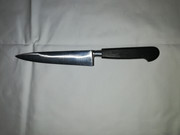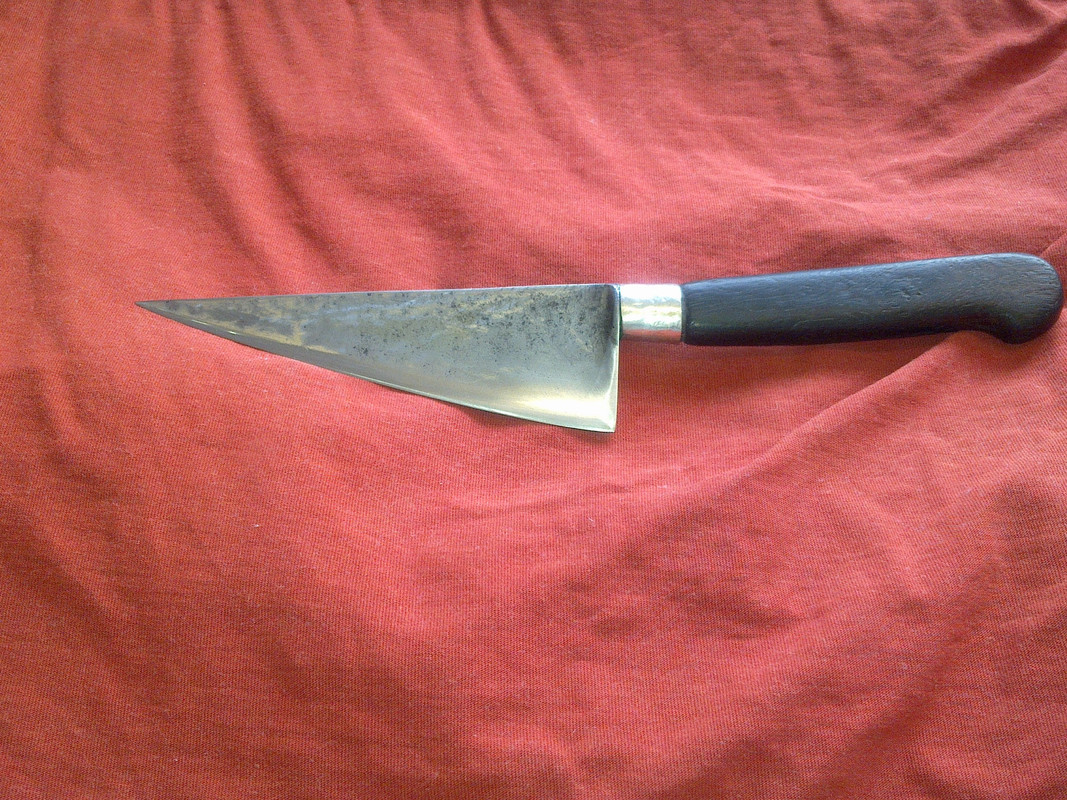4 knives to look at.
1. test handle - ultra skinny
spine thickness at handle 2.4mm, 25mm tall X 12mm wide
Surprisingly comfortable for chopping. The place the skinny handle sucks is sharpening. I've been practicing kasumi with this blade so I've flattened the bevels and then been testing a bunch of different stones on it. It's a workout in a carpal tunnel kind of way. I've been wrapping a rag around it and rubberbanding it.
2. typical japanese Western - dimensions at bolster 24mm tall X 16mm wide, 2.0mm where spine meets bolster
Very comfortable. No real distal taper on this one because its cheap prefab San Mai, but the handle ergonomics on this type of blade really work for me. Lots of this construction in my work kit. I would want them sized up to about 28mm tall with the same ratio as the little gyuto so about 18-19mm wide and at least a 4-5mm spine (tapered toward the tip and the butt) for a 240mm knife.
3. typical Sabatier - dimensions at bolster 17mm tall X 16mm wide, 5.6mm where spine meets bolster
I like the basic construction here. significant distal taper (GOOD), a little dainty for the length of the blade and for my hands and it's too square/round for me, not enough oval/rectangle. And ditch the finger guard and crummy steel obviously. But this general idea is great. The dimensions a little further back are better for me if they just extended all the way to the bolster instead of having an elegant little taper. At the first rivet the knife is 21mm tall and 21mm wide. Again I like a taller rectangle like the Japanese style better than the square style. But overall, I love using the Sabatier.
4. Shi.Han - dimensions at top of ferrule 24mm tall X 20mm wide, 4.0mm at spine
I'm just including this because it's my favorite handle. It narrowly edges out my Watanabe. I don't really own a high caliber Western yet. This knife pretty closely captures my favorite dimensions and ergonomics though. It's a big handle, but I wouldn't mind it being even a little bigger. I don't like the huge gap between the handle and the choil. That's one of the things I find more comfortable on Westerns than Was. It bothers me more on my Watanabe than on this knife. For me, the hexagon shape is way better than a square or a circle or a Watanabe D. It's taller than it is wide. Excellent distal taper. But my ideal Western handle wouldn't get skinny near the bolster. It would be the same the thickness and shape from the top of the bolster to at least the middle of the handle. And it would be about 28mm tall and 20mm wide. Interestingly, at least to me, is those dimensions roughly match the height of the handle at the heel of the Shi.han and the width of the handle at the ferrule.
As far as other hand positions. I am sure I use other hand positions but mostly for gyutos, especially the really repetitive stuff where you can measure how much produce that thing is chopping by the bushel, it's mostly going to be a pretty aggressive pinch grip. When dealing with wet, oily ingredients a nice Western just feels so much more in control. A slippery Watanabe is like a Ferrari with bad brakes. Hopefully my phone is charged up enough now to take some pictures. I really gotta get a new battery for that thing.
View attachment 67181 View attachment 67182


























